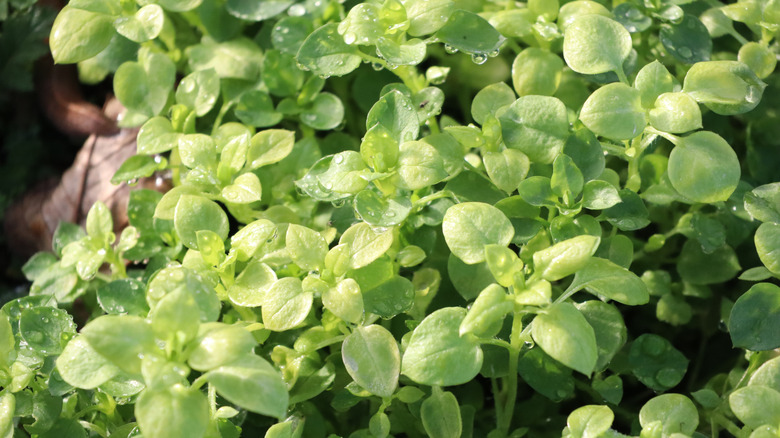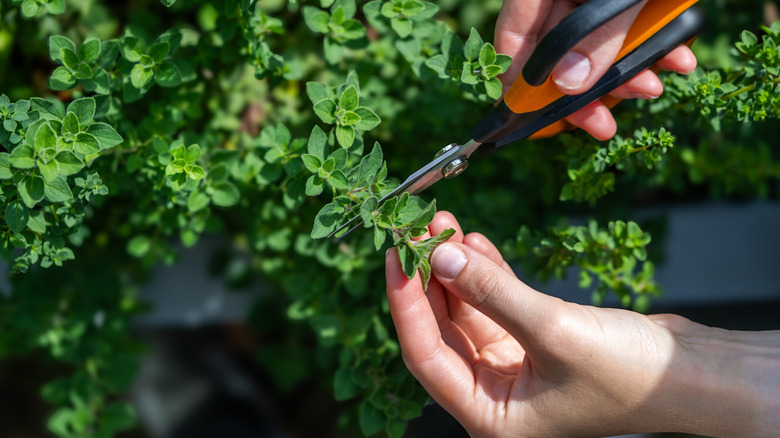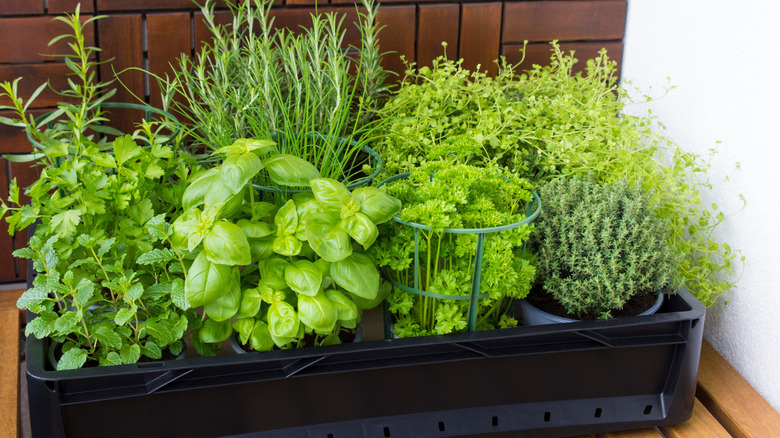How To Prep Your Oregano Plants For Winter So They Come Back Thriving In Spring
Oregano is a popular and delicious herb used in many dishes around the world. Not only does it taste amazing, but it's a helpful plant to grow in your yard to slow down pests. For example, this fragrant herb will keep rabbits out of the garden. Even better, oregano can be a perennial in most U.S. regions (USDA Hardiness Zones 4 through 11) without much effort. However, in colder locations, it is sometimes treated as an annual. With the right winter preparation, though, oregano can survive until the spring even if your climate is cooler than it usually tolerates.
Essentially, it comes down to making sure your plant has exactly what it needs when the cold hits and is as protected as it can be. Proper pruning, a thick layer of ground cover, and the right amount of moisture are all important to ensure that your oregano can remain alive in colder temperatures and live for many seasons like a perennial. These steps take a little work, but it's well worth it to have this delicious herb come back next year. By taking these steps and ensuring you avoid the biggest mistakes that are made when growing oregano, you will have a happy and healthy plant that lasts for several years, no matter the zone you live in.
Why you should prune and mulch oregano plants in winter
The first step is to prune your oregano. Generally, this is done in late fall, before the temperatures drop. You want to cut the stems to no more than 4 to 6 inches tall to reduce the risk of damage from frost. This is also the perfect time to look over your plant and make sure it's looking healthy. Damaged or malformed growth just takes more energy from your oregano, and by trimming these parts off, your oregano can focus on surviving the cold.
Water is something else to take into account when overwintering your oregano. These plants need a fair amount of water, but you don't want them to be too wet when the cold comes. Give your oregano a few heavy rounds of watering before the first frost is set to arrive, just to make sure they have enough hydration to get through the chilliest of months.
If you are using fertilizer on your oregano, late fall is also the time to cut back. Nitrogen is great in the spring to promote new growth, but you actually want to allow your oregano to slow down and go dormant in cold weather. A better option is to put a layer of mulch or compost over the ground once the ground begins to freeze. Not only do these materials add some nutrients, but they also help to hold heat in the soil to protect the plant and its root, and stop as much moisture loss.
Should you bring oregano indoors for the winter?
If your temperatures in the winter are just too cold, another option is to move your oregano inside. Ideally, if you know your herb won't handle the winter well, you should plant it in a pot you can easily move inside or outside as the seasons change. However, if you hadn't thought that far ahead when planting your oregano, you can transplant it.
You'll want to dig the plant out of the earth before the temperature decreases too much and while the soil is still soft. Be careful to keep the roots intact. You also want to make sure the pot is big enough so that the roots have plenty of space to spread out and grow. Once you plant your oregano in the pot, give it some time to adjust. Leave it outside for a few days in a sheltered, shaded area. Then, you can bring it inside for the winter, placing it in a sunny area. From there, you can place it back in your garden, come spring. Or, if you want to reduce your workload and reduce stress on the plant, you can also just leave the oregano potted all year and move it around as needed.
If you want this plant to be both in your garden and in a pot, that's easy to do, since there's an herb propagation technique for a never-ending supply of oregano: taking cuttings. Simply snip a few pieces of your plant and root them in another container full of water or potting soil, then plant them as usual. With this technique, you can keep oregano both indoors and outdoors, and you never have to worry about running out of your favorite herb.


